Business Research: Marketing Strategies and Jeni's Ice Cream Profit
VerifiedAdded on 2021/05/27
|20
|4715
|389
Report
AI Summary
This project proposal examines the impact of marketing strategies on the profitability of Jeni's Splendid Ice Cream Company in the USA. The study aims to explore the marketing strategies adopted by Jeni's, assess key factors influencing profitability, and investigate the challenges faced during implementation. The report includes an introduction to marketing strategies, a problem statement highlighting the importance of marketing in driving revenue and profit, and a detailed discussion on the aim, objectives, and research questions. It also provides justification for the research, outlining its potential benefits for future researchers and businesses. The conceptual framework covers concepts on marketing strategies, types of strategies (interactive, digital, and online), and key factors influencing profitability. The methodology section outlines the research approach, data sources, data collection and analysis techniques, project organization, budget, and schedule. The study will analyze the last five years of revenue data and aims to contribute to the understanding of the relationship between marketing efforts and financial performance in the ice cream industry.
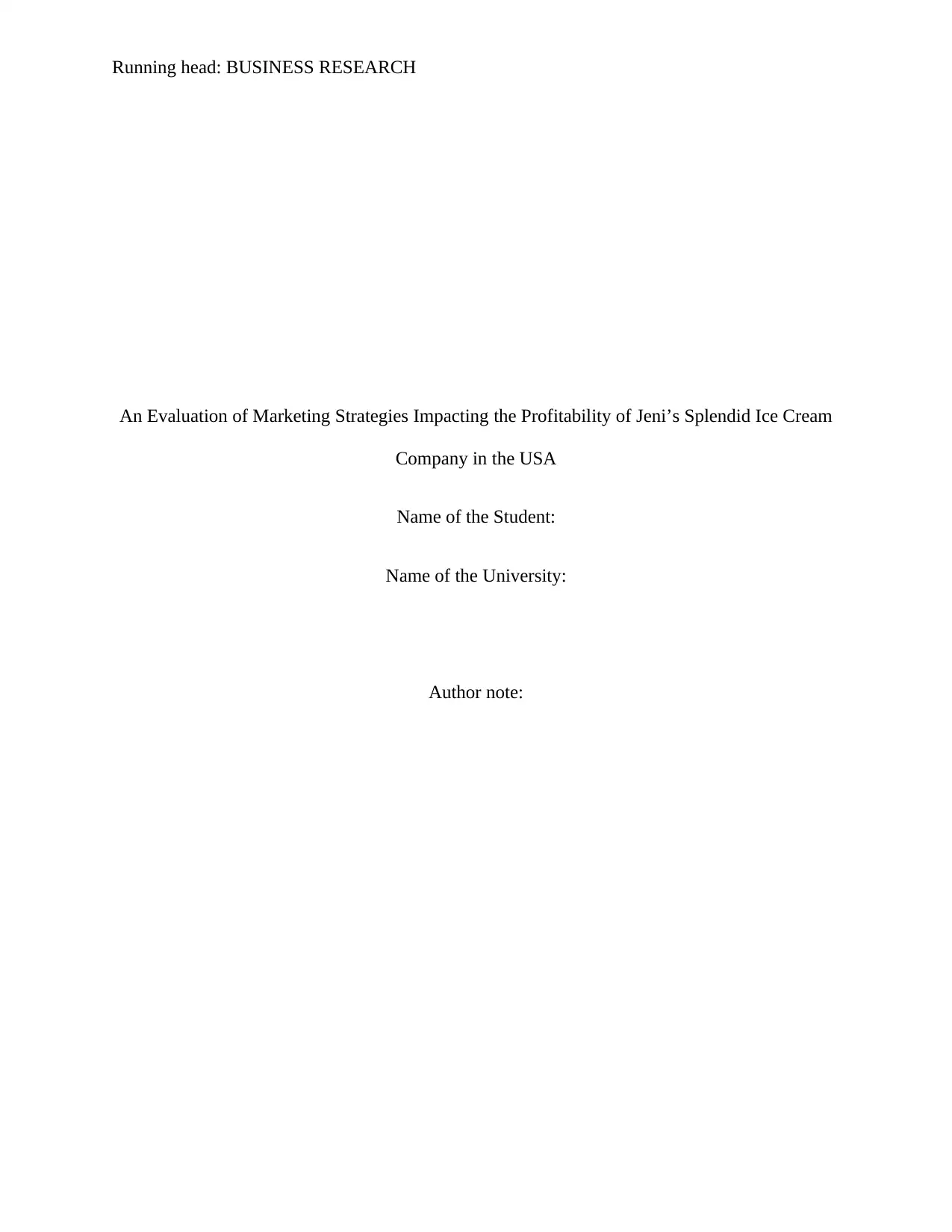
Running head: BUSINESS RESEARCH
An Evaluation of Marketing Strategies Impacting the Profitability of Jeni’s Splendid Ice Cream
Company in the USA
Name of the Student:
Name of the University:
Author note:
An Evaluation of Marketing Strategies Impacting the Profitability of Jeni’s Splendid Ice Cream
Company in the USA
Name of the Student:
Name of the University:
Author note:
Paraphrase This Document
Need a fresh take? Get an instant paraphrase of this document with our AI Paraphraser
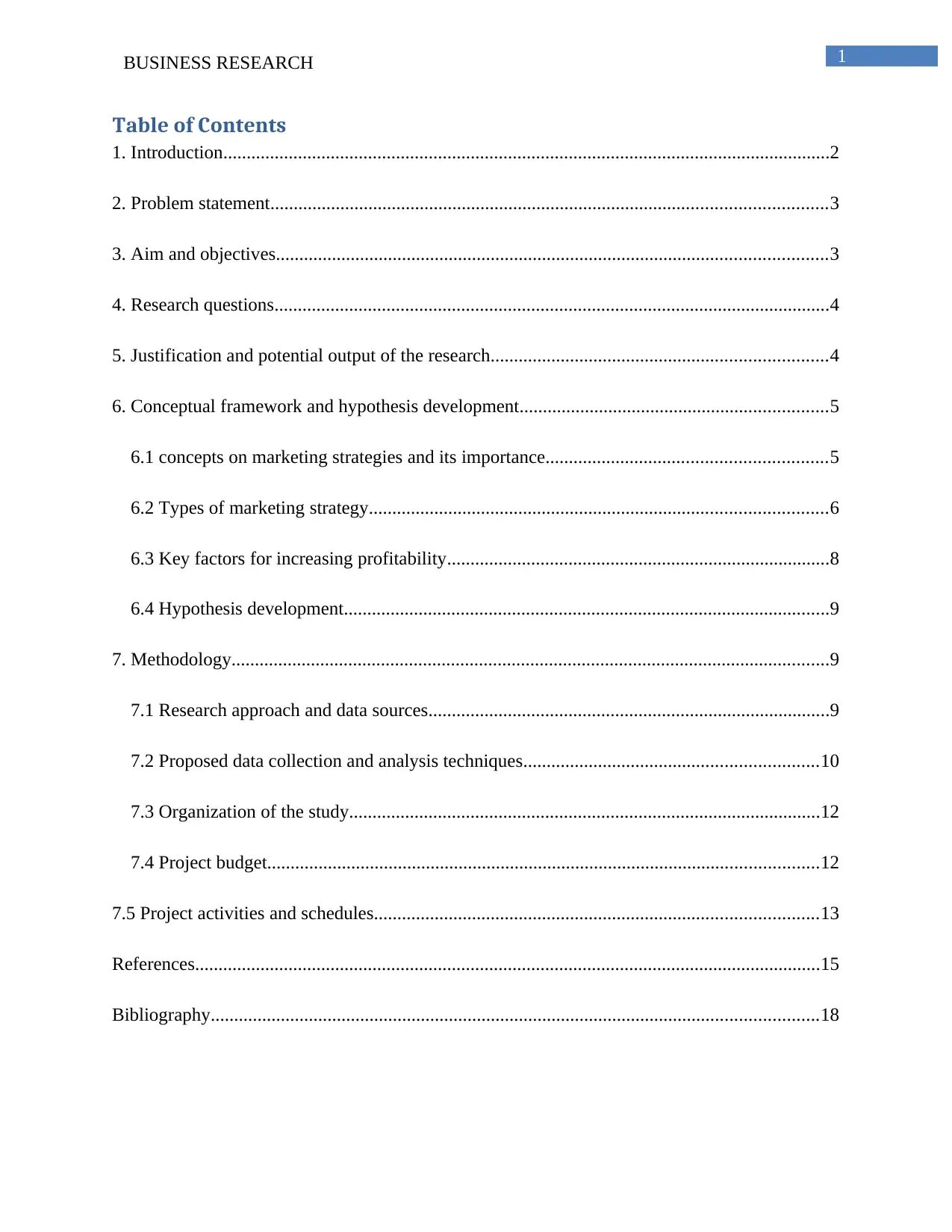
1BUSINESS RESEARCH
Table of Contents
1. Introduction..................................................................................................................................2
2. Problem statement.......................................................................................................................3
3. Aim and objectives......................................................................................................................3
4. Research questions.......................................................................................................................4
5. Justification and potential output of the research........................................................................4
6. Conceptual framework and hypothesis development..................................................................5
6.1 concepts on marketing strategies and its importance............................................................5
6.2 Types of marketing strategy..................................................................................................6
6.3 Key factors for increasing profitability..................................................................................8
6.4 Hypothesis development........................................................................................................9
7. Methodology................................................................................................................................9
7.1 Research approach and data sources......................................................................................9
7.2 Proposed data collection and analysis techniques...............................................................10
7.3 Organization of the study.....................................................................................................12
7.4 Project budget......................................................................................................................12
7.5 Project activities and schedules...............................................................................................13
References......................................................................................................................................15
Bibliography..................................................................................................................................18
Table of Contents
1. Introduction..................................................................................................................................2
2. Problem statement.......................................................................................................................3
3. Aim and objectives......................................................................................................................3
4. Research questions.......................................................................................................................4
5. Justification and potential output of the research........................................................................4
6. Conceptual framework and hypothesis development..................................................................5
6.1 concepts on marketing strategies and its importance............................................................5
6.2 Types of marketing strategy..................................................................................................6
6.3 Key factors for increasing profitability..................................................................................8
6.4 Hypothesis development........................................................................................................9
7. Methodology................................................................................................................................9
7.1 Research approach and data sources......................................................................................9
7.2 Proposed data collection and analysis techniques...............................................................10
7.3 Organization of the study.....................................................................................................12
7.4 Project budget......................................................................................................................12
7.5 Project activities and schedules...............................................................................................13
References......................................................................................................................................15
Bibliography..................................................................................................................................18
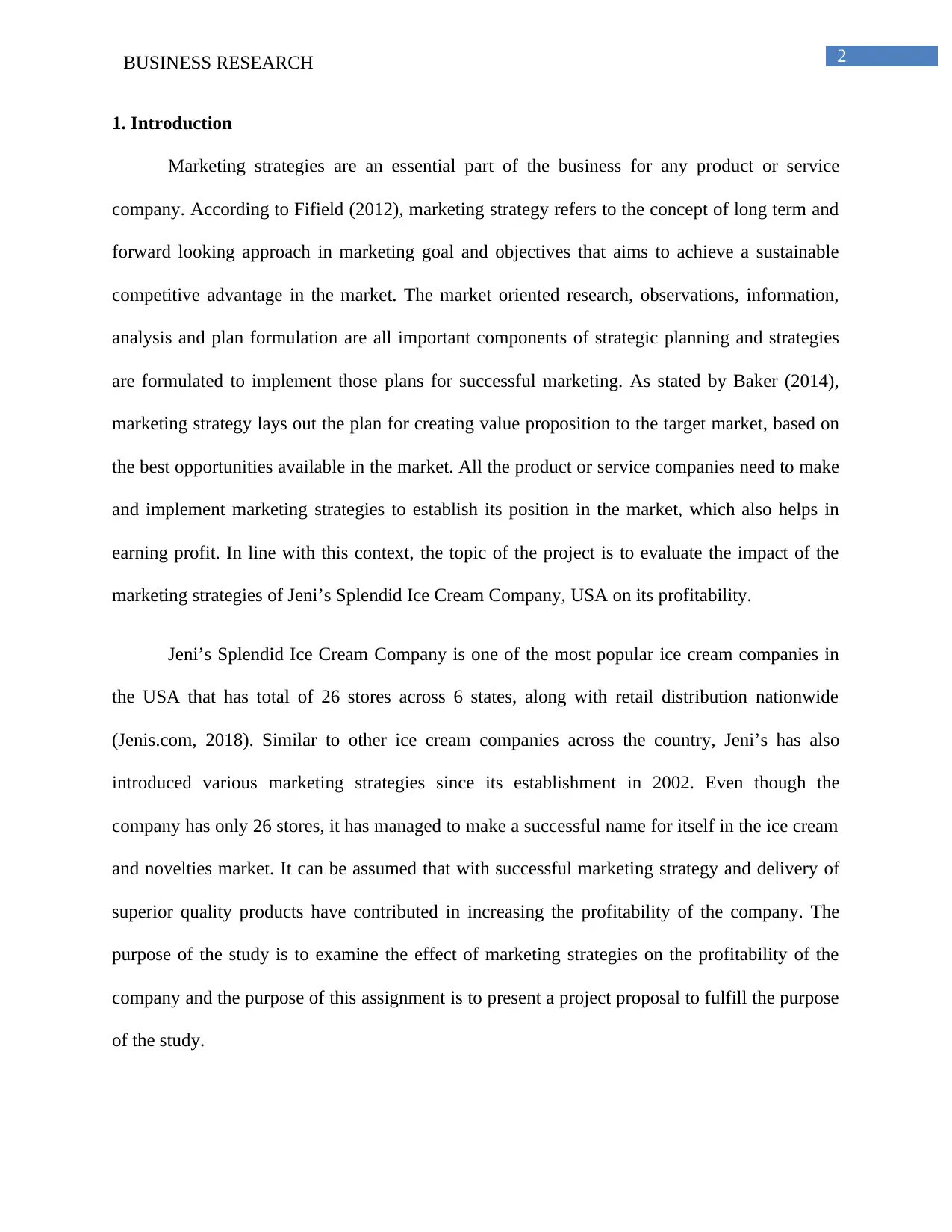
2BUSINESS RESEARCH
1. Introduction
Marketing strategies are an essential part of the business for any product or service
company. According to Fifield (2012), marketing strategy refers to the concept of long term and
forward looking approach in marketing goal and objectives that aims to achieve a sustainable
competitive advantage in the market. The market oriented research, observations, information,
analysis and plan formulation are all important components of strategic planning and strategies
are formulated to implement those plans for successful marketing. As stated by Baker (2014),
marketing strategy lays out the plan for creating value proposition to the target market, based on
the best opportunities available in the market. All the product or service companies need to make
and implement marketing strategies to establish its position in the market, which also helps in
earning profit. In line with this context, the topic of the project is to evaluate the impact of the
marketing strategies of Jeni’s Splendid Ice Cream Company, USA on its profitability.
Jeni’s Splendid Ice Cream Company is one of the most popular ice cream companies in
the USA that has total of 26 stores across 6 states, along with retail distribution nationwide
(Jenis.com, 2018). Similar to other ice cream companies across the country, Jeni’s has also
introduced various marketing strategies since its establishment in 2002. Even though the
company has only 26 stores, it has managed to make a successful name for itself in the ice cream
and novelties market. It can be assumed that with successful marketing strategy and delivery of
superior quality products have contributed in increasing the profitability of the company. The
purpose of the study is to examine the effect of marketing strategies on the profitability of the
company and the purpose of this assignment is to present a project proposal to fulfill the purpose
of the study.
1. Introduction
Marketing strategies are an essential part of the business for any product or service
company. According to Fifield (2012), marketing strategy refers to the concept of long term and
forward looking approach in marketing goal and objectives that aims to achieve a sustainable
competitive advantage in the market. The market oriented research, observations, information,
analysis and plan formulation are all important components of strategic planning and strategies
are formulated to implement those plans for successful marketing. As stated by Baker (2014),
marketing strategy lays out the plan for creating value proposition to the target market, based on
the best opportunities available in the market. All the product or service companies need to make
and implement marketing strategies to establish its position in the market, which also helps in
earning profit. In line with this context, the topic of the project is to evaluate the impact of the
marketing strategies of Jeni’s Splendid Ice Cream Company, USA on its profitability.
Jeni’s Splendid Ice Cream Company is one of the most popular ice cream companies in
the USA that has total of 26 stores across 6 states, along with retail distribution nationwide
(Jenis.com, 2018). Similar to other ice cream companies across the country, Jeni’s has also
introduced various marketing strategies since its establishment in 2002. Even though the
company has only 26 stores, it has managed to make a successful name for itself in the ice cream
and novelties market. It can be assumed that with successful marketing strategy and delivery of
superior quality products have contributed in increasing the profitability of the company. The
purpose of the study is to examine the effect of marketing strategies on the profitability of the
company and the purpose of this assignment is to present a project proposal to fulfill the purpose
of the study.
⊘ This is a preview!⊘
Do you want full access?
Subscribe today to unlock all pages.

Trusted by 1+ million students worldwide
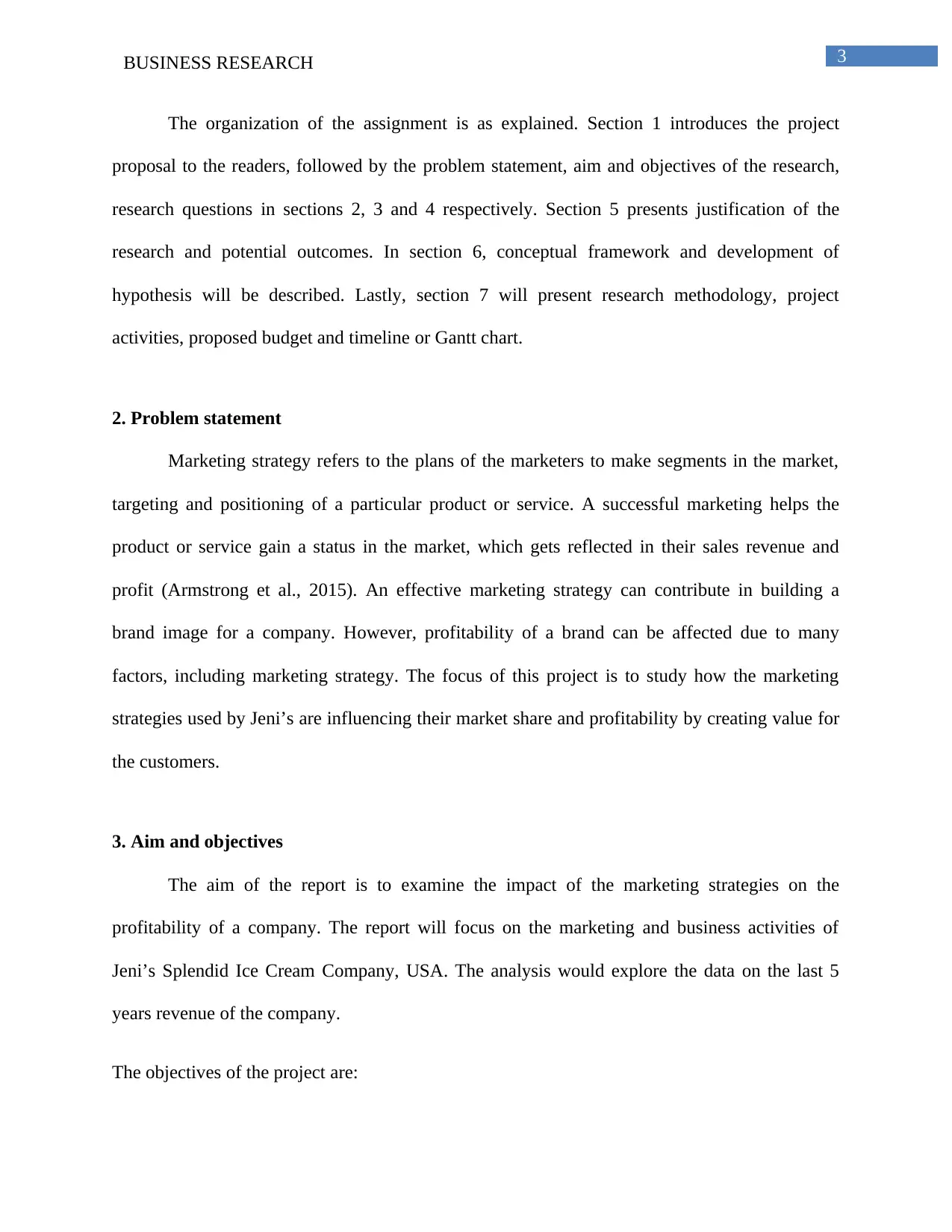
3BUSINESS RESEARCH
The organization of the assignment is as explained. Section 1 introduces the project
proposal to the readers, followed by the problem statement, aim and objectives of the research,
research questions in sections 2, 3 and 4 respectively. Section 5 presents justification of the
research and potential outcomes. In section 6, conceptual framework and development of
hypothesis will be described. Lastly, section 7 will present research methodology, project
activities, proposed budget and timeline or Gantt chart.
2. Problem statement
Marketing strategy refers to the plans of the marketers to make segments in the market,
targeting and positioning of a particular product or service. A successful marketing helps the
product or service gain a status in the market, which gets reflected in their sales revenue and
profit (Armstrong et al., 2015). An effective marketing strategy can contribute in building a
brand image for a company. However, profitability of a brand can be affected due to many
factors, including marketing strategy. The focus of this project is to study how the marketing
strategies used by Jeni’s are influencing their market share and profitability by creating value for
the customers.
3. Aim and objectives
The aim of the report is to examine the impact of the marketing strategies on the
profitability of a company. The report will focus on the marketing and business activities of
Jeni’s Splendid Ice Cream Company, USA. The analysis would explore the data on the last 5
years revenue of the company.
The objectives of the project are:
The organization of the assignment is as explained. Section 1 introduces the project
proposal to the readers, followed by the problem statement, aim and objectives of the research,
research questions in sections 2, 3 and 4 respectively. Section 5 presents justification of the
research and potential outcomes. In section 6, conceptual framework and development of
hypothesis will be described. Lastly, section 7 will present research methodology, project
activities, proposed budget and timeline or Gantt chart.
2. Problem statement
Marketing strategy refers to the plans of the marketers to make segments in the market,
targeting and positioning of a particular product or service. A successful marketing helps the
product or service gain a status in the market, which gets reflected in their sales revenue and
profit (Armstrong et al., 2015). An effective marketing strategy can contribute in building a
brand image for a company. However, profitability of a brand can be affected due to many
factors, including marketing strategy. The focus of this project is to study how the marketing
strategies used by Jeni’s are influencing their market share and profitability by creating value for
the customers.
3. Aim and objectives
The aim of the report is to examine the impact of the marketing strategies on the
profitability of a company. The report will focus on the marketing and business activities of
Jeni’s Splendid Ice Cream Company, USA. The analysis would explore the data on the last 5
years revenue of the company.
The objectives of the project are:
Paraphrase This Document
Need a fresh take? Get an instant paraphrase of this document with our AI Paraphraser
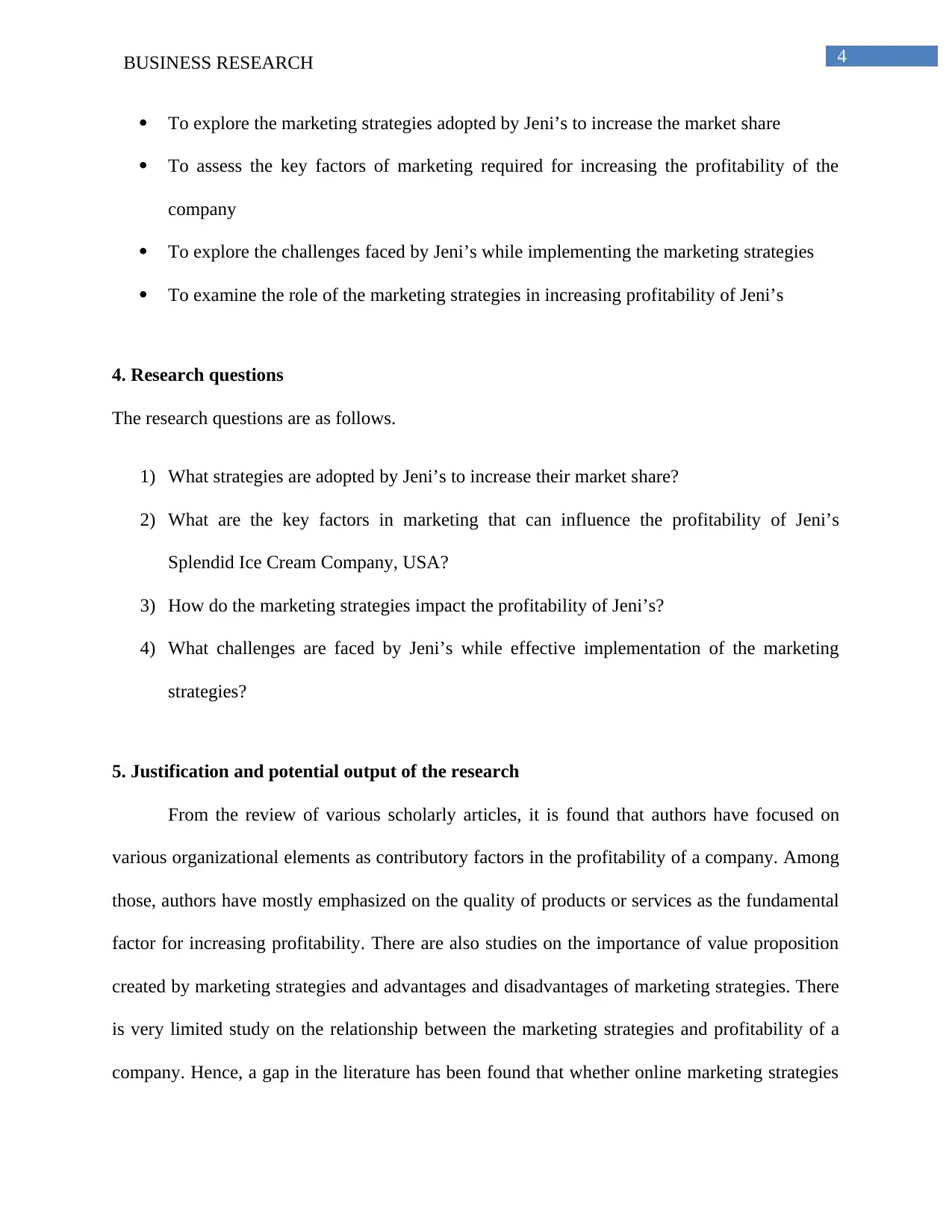
4BUSINESS RESEARCH
To explore the marketing strategies adopted by Jeni’s to increase the market share
To assess the key factors of marketing required for increasing the profitability of the
company
To explore the challenges faced by Jeni’s while implementing the marketing strategies
To examine the role of the marketing strategies in increasing profitability of Jeni’s
4. Research questions
The research questions are as follows.
1) What strategies are adopted by Jeni’s to increase their market share?
2) What are the key factors in marketing that can influence the profitability of Jeni’s
Splendid Ice Cream Company, USA?
3) How do the marketing strategies impact the profitability of Jeni’s?
4) What challenges are faced by Jeni’s while effective implementation of the marketing
strategies?
5. Justification and potential output of the research
From the review of various scholarly articles, it is found that authors have focused on
various organizational elements as contributory factors in the profitability of a company. Among
those, authors have mostly emphasized on the quality of products or services as the fundamental
factor for increasing profitability. There are also studies on the importance of value proposition
created by marketing strategies and advantages and disadvantages of marketing strategies. There
is very limited study on the relationship between the marketing strategies and profitability of a
company. Hence, a gap in the literature has been found that whether online marketing strategies
To explore the marketing strategies adopted by Jeni’s to increase the market share
To assess the key factors of marketing required for increasing the profitability of the
company
To explore the challenges faced by Jeni’s while implementing the marketing strategies
To examine the role of the marketing strategies in increasing profitability of Jeni’s
4. Research questions
The research questions are as follows.
1) What strategies are adopted by Jeni’s to increase their market share?
2) What are the key factors in marketing that can influence the profitability of Jeni’s
Splendid Ice Cream Company, USA?
3) How do the marketing strategies impact the profitability of Jeni’s?
4) What challenges are faced by Jeni’s while effective implementation of the marketing
strategies?
5. Justification and potential output of the research
From the review of various scholarly articles, it is found that authors have focused on
various organizational elements as contributory factors in the profitability of a company. Among
those, authors have mostly emphasized on the quality of products or services as the fundamental
factor for increasing profitability. There are also studies on the importance of value proposition
created by marketing strategies and advantages and disadvantages of marketing strategies. There
is very limited study on the relationship between the marketing strategies and profitability of a
company. Hence, a gap in the literature has been found that whether online marketing strategies
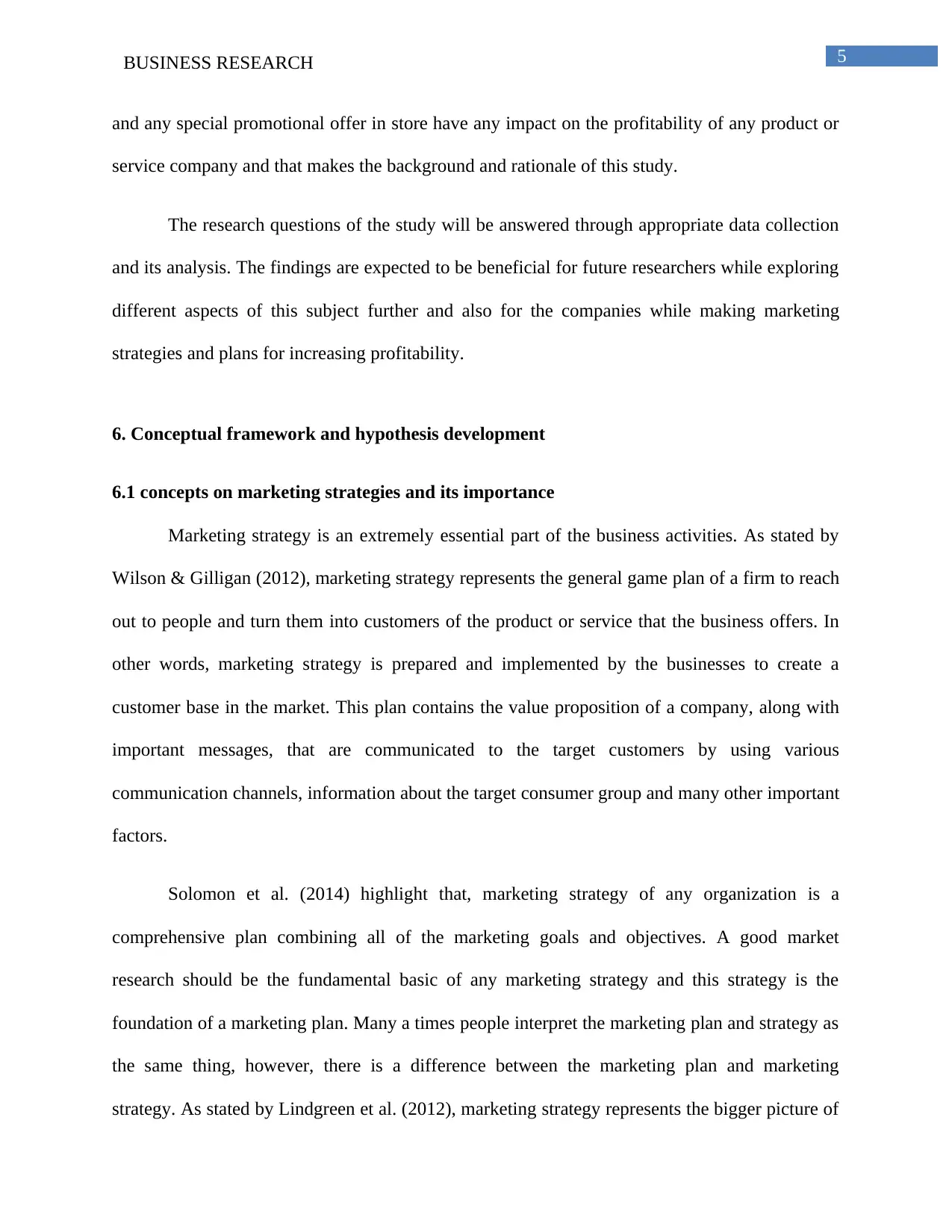
5BUSINESS RESEARCH
and any special promotional offer in store have any impact on the profitability of any product or
service company and that makes the background and rationale of this study.
The research questions of the study will be answered through appropriate data collection
and its analysis. The findings are expected to be beneficial for future researchers while exploring
different aspects of this subject further and also for the companies while making marketing
strategies and plans for increasing profitability.
6. Conceptual framework and hypothesis development
6.1 concepts on marketing strategies and its importance
Marketing strategy is an extremely essential part of the business activities. As stated by
Wilson & Gilligan (2012), marketing strategy represents the general game plan of a firm to reach
out to people and turn them into customers of the product or service that the business offers. In
other words, marketing strategy is prepared and implemented by the businesses to create a
customer base in the market. This plan contains the value proposition of a company, along with
important messages, that are communicated to the target customers by using various
communication channels, information about the target consumer group and many other important
factors.
Solomon et al. (2014) highlight that, marketing strategy of any organization is a
comprehensive plan combining all of the marketing goals and objectives. A good market
research should be the fundamental basic of any marketing strategy and this strategy is the
foundation of a marketing plan. Many a times people interpret the marketing plan and strategy as
the same thing, however, there is a difference between the marketing plan and marketing
strategy. As stated by Lindgreen et al. (2012), marketing strategy represents the bigger picture of
and any special promotional offer in store have any impact on the profitability of any product or
service company and that makes the background and rationale of this study.
The research questions of the study will be answered through appropriate data collection
and its analysis. The findings are expected to be beneficial for future researchers while exploring
different aspects of this subject further and also for the companies while making marketing
strategies and plans for increasing profitability.
6. Conceptual framework and hypothesis development
6.1 concepts on marketing strategies and its importance
Marketing strategy is an extremely essential part of the business activities. As stated by
Wilson & Gilligan (2012), marketing strategy represents the general game plan of a firm to reach
out to people and turn them into customers of the product or service that the business offers. In
other words, marketing strategy is prepared and implemented by the businesses to create a
customer base in the market. This plan contains the value proposition of a company, along with
important messages, that are communicated to the target customers by using various
communication channels, information about the target consumer group and many other important
factors.
Solomon et al. (2014) highlight that, marketing strategy of any organization is a
comprehensive plan combining all of the marketing goals and objectives. A good market
research should be the fundamental basic of any marketing strategy and this strategy is the
foundation of a marketing plan. Many a times people interpret the marketing plan and strategy as
the same thing, however, there is a difference between the marketing plan and marketing
strategy. As stated by Lindgreen et al. (2012), marketing strategy represents the bigger picture of
⊘ This is a preview!⊘
Do you want full access?
Subscribe today to unlock all pages.

Trusted by 1+ million students worldwide
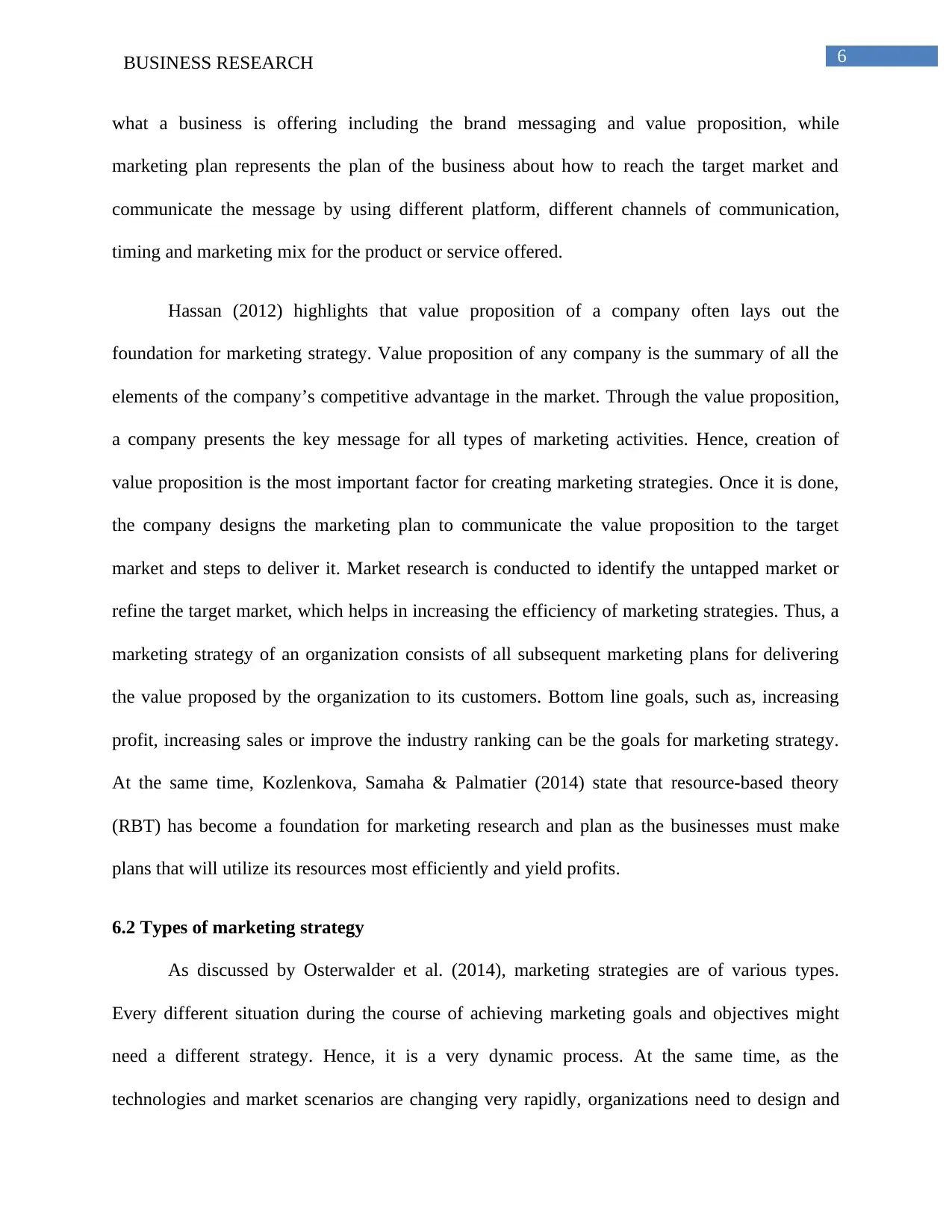
6BUSINESS RESEARCH
what a business is offering including the brand messaging and value proposition, while
marketing plan represents the plan of the business about how to reach the target market and
communicate the message by using different platform, different channels of communication,
timing and marketing mix for the product or service offered.
Hassan (2012) highlights that value proposition of a company often lays out the
foundation for marketing strategy. Value proposition of any company is the summary of all the
elements of the company’s competitive advantage in the market. Through the value proposition,
a company presents the key message for all types of marketing activities. Hence, creation of
value proposition is the most important factor for creating marketing strategies. Once it is done,
the company designs the marketing plan to communicate the value proposition to the target
market and steps to deliver it. Market research is conducted to identify the untapped market or
refine the target market, which helps in increasing the efficiency of marketing strategies. Thus, a
marketing strategy of an organization consists of all subsequent marketing plans for delivering
the value proposed by the organization to its customers. Bottom line goals, such as, increasing
profit, increasing sales or improve the industry ranking can be the goals for marketing strategy.
At the same time, Kozlenkova, Samaha & Palmatier (2014) state that resource-based theory
(RBT) has become a foundation for marketing research and plan as the businesses must make
plans that will utilize its resources most efficiently and yield profits.
6.2 Types of marketing strategy
As discussed by Osterwalder et al. (2014), marketing strategies are of various types.
Every different situation during the course of achieving marketing goals and objectives might
need a different strategy. Hence, it is a very dynamic process. At the same time, as the
technologies and market scenarios are changing very rapidly, organizations need to design and
what a business is offering including the brand messaging and value proposition, while
marketing plan represents the plan of the business about how to reach the target market and
communicate the message by using different platform, different channels of communication,
timing and marketing mix for the product or service offered.
Hassan (2012) highlights that value proposition of a company often lays out the
foundation for marketing strategy. Value proposition of any company is the summary of all the
elements of the company’s competitive advantage in the market. Through the value proposition,
a company presents the key message for all types of marketing activities. Hence, creation of
value proposition is the most important factor for creating marketing strategies. Once it is done,
the company designs the marketing plan to communicate the value proposition to the target
market and steps to deliver it. Market research is conducted to identify the untapped market or
refine the target market, which helps in increasing the efficiency of marketing strategies. Thus, a
marketing strategy of an organization consists of all subsequent marketing plans for delivering
the value proposed by the organization to its customers. Bottom line goals, such as, increasing
profit, increasing sales or improve the industry ranking can be the goals for marketing strategy.
At the same time, Kozlenkova, Samaha & Palmatier (2014) state that resource-based theory
(RBT) has become a foundation for marketing research and plan as the businesses must make
plans that will utilize its resources most efficiently and yield profits.
6.2 Types of marketing strategy
As discussed by Osterwalder et al. (2014), marketing strategies are of various types.
Every different situation during the course of achieving marketing goals and objectives might
need a different strategy. Hence, it is a very dynamic process. At the same time, as the
technologies and market scenarios are changing very rapidly, organizations need to design and
Paraphrase This Document
Need a fresh take? Get an instant paraphrase of this document with our AI Paraphraser
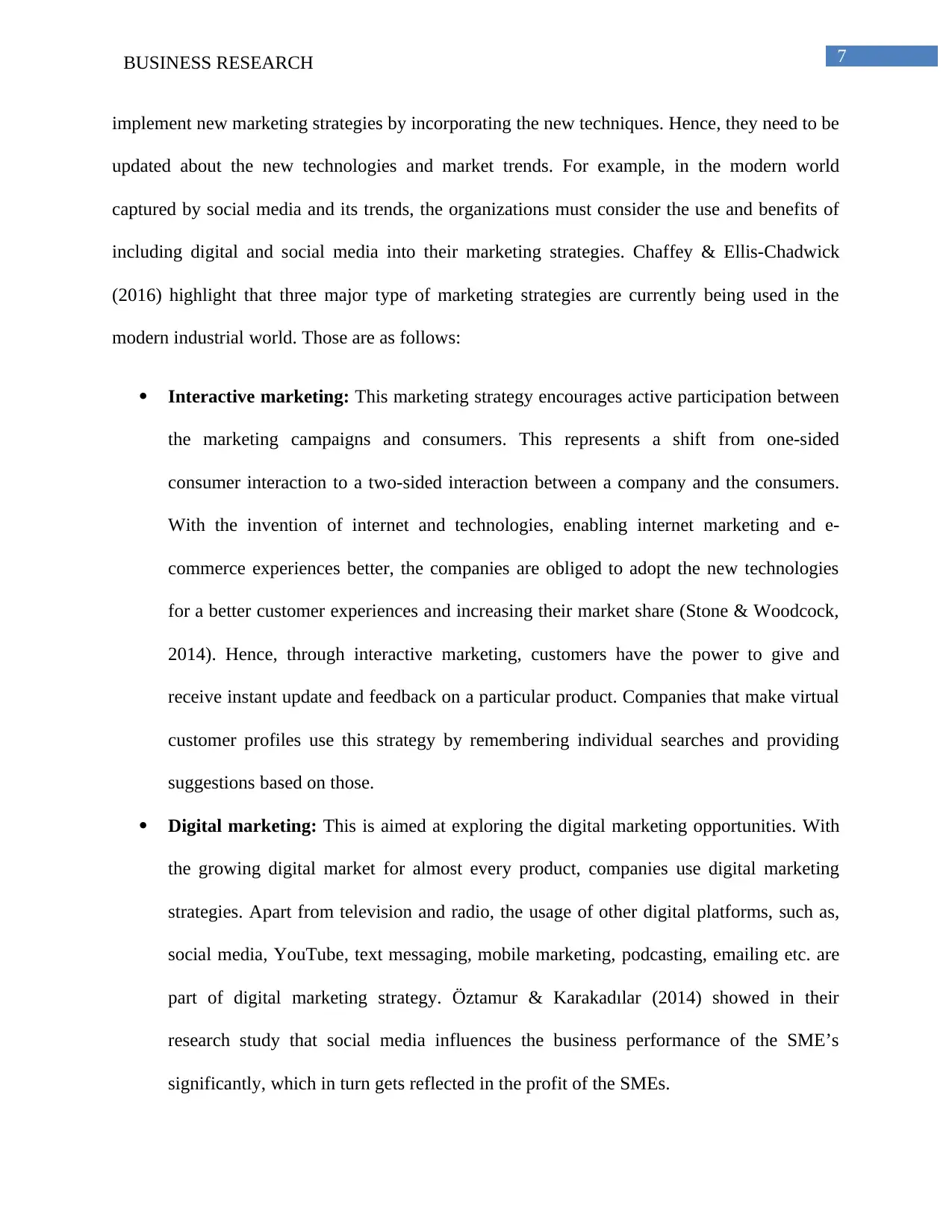
7BUSINESS RESEARCH
implement new marketing strategies by incorporating the new techniques. Hence, they need to be
updated about the new technologies and market trends. For example, in the modern world
captured by social media and its trends, the organizations must consider the use and benefits of
including digital and social media into their marketing strategies. Chaffey & Ellis-Chadwick
(2016) highlight that three major type of marketing strategies are currently being used in the
modern industrial world. Those are as follows:
Interactive marketing: This marketing strategy encourages active participation between
the marketing campaigns and consumers. This represents a shift from one-sided
consumer interaction to a two-sided interaction between a company and the consumers.
With the invention of internet and technologies, enabling internet marketing and e-
commerce experiences better, the companies are obliged to adopt the new technologies
for a better customer experiences and increasing their market share (Stone & Woodcock,
2014). Hence, through interactive marketing, customers have the power to give and
receive instant update and feedback on a particular product. Companies that make virtual
customer profiles use this strategy by remembering individual searches and providing
suggestions based on those.
Digital marketing: This is aimed at exploring the digital marketing opportunities. With
the growing digital market for almost every product, companies use digital marketing
strategies. Apart from television and radio, the usage of other digital platforms, such as,
social media, YouTube, text messaging, mobile marketing, podcasting, emailing etc. are
part of digital marketing strategy. Öztamur & Karakadılar (2014) showed in their
research study that social media influences the business performance of the SME’s
significantly, which in turn gets reflected in the profit of the SMEs.
implement new marketing strategies by incorporating the new techniques. Hence, they need to be
updated about the new technologies and market trends. For example, in the modern world
captured by social media and its trends, the organizations must consider the use and benefits of
including digital and social media into their marketing strategies. Chaffey & Ellis-Chadwick
(2016) highlight that three major type of marketing strategies are currently being used in the
modern industrial world. Those are as follows:
Interactive marketing: This marketing strategy encourages active participation between
the marketing campaigns and consumers. This represents a shift from one-sided
consumer interaction to a two-sided interaction between a company and the consumers.
With the invention of internet and technologies, enabling internet marketing and e-
commerce experiences better, the companies are obliged to adopt the new technologies
for a better customer experiences and increasing their market share (Stone & Woodcock,
2014). Hence, through interactive marketing, customers have the power to give and
receive instant update and feedback on a particular product. Companies that make virtual
customer profiles use this strategy by remembering individual searches and providing
suggestions based on those.
Digital marketing: This is aimed at exploring the digital marketing opportunities. With
the growing digital market for almost every product, companies use digital marketing
strategies. Apart from television and radio, the usage of other digital platforms, such as,
social media, YouTube, text messaging, mobile marketing, podcasting, emailing etc. are
part of digital marketing strategy. Öztamur & Karakadılar (2014) showed in their
research study that social media influences the business performance of the SME’s
significantly, which in turn gets reflected in the profit of the SMEs.
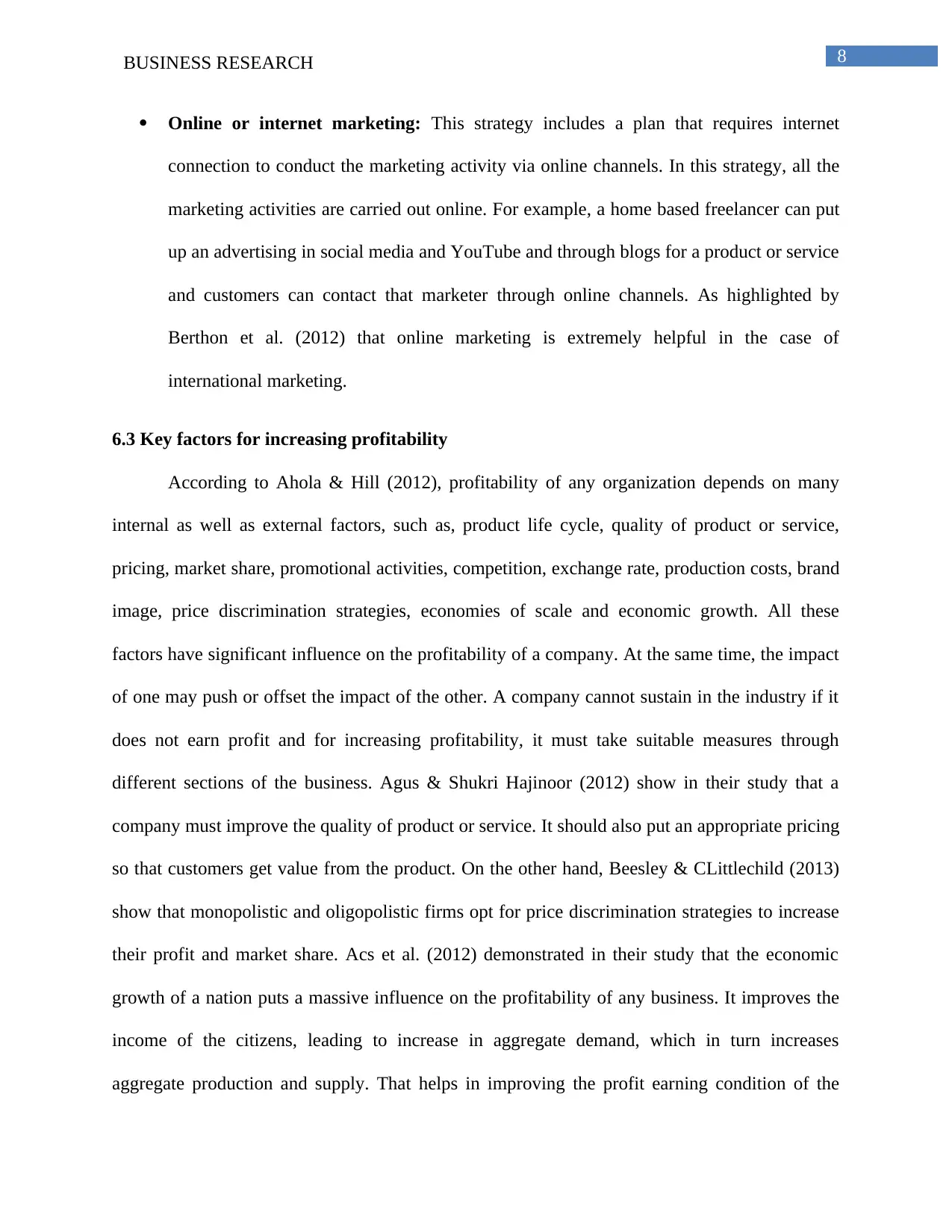
8BUSINESS RESEARCH
Online or internet marketing: This strategy includes a plan that requires internet
connection to conduct the marketing activity via online channels. In this strategy, all the
marketing activities are carried out online. For example, a home based freelancer can put
up an advertising in social media and YouTube and through blogs for a product or service
and customers can contact that marketer through online channels. As highlighted by
Berthon et al. (2012) that online marketing is extremely helpful in the case of
international marketing.
6.3 Key factors for increasing profitability
According to Ahola & Hill (2012), profitability of any organization depends on many
internal as well as external factors, such as, product life cycle, quality of product or service,
pricing, market share, promotional activities, competition, exchange rate, production costs, brand
image, price discrimination strategies, economies of scale and economic growth. All these
factors have significant influence on the profitability of a company. At the same time, the impact
of one may push or offset the impact of the other. A company cannot sustain in the industry if it
does not earn profit and for increasing profitability, it must take suitable measures through
different sections of the business. Agus & Shukri Hajinoor (2012) show in their study that a
company must improve the quality of product or service. It should also put an appropriate pricing
so that customers get value from the product. On the other hand, Beesley & CLittlechild (2013)
show that monopolistic and oligopolistic firms opt for price discrimination strategies to increase
their profit and market share. Acs et al. (2012) demonstrated in their study that the economic
growth of a nation puts a massive influence on the profitability of any business. It improves the
income of the citizens, leading to increase in aggregate demand, which in turn increases
aggregate production and supply. That helps in improving the profit earning condition of the
Online or internet marketing: This strategy includes a plan that requires internet
connection to conduct the marketing activity via online channels. In this strategy, all the
marketing activities are carried out online. For example, a home based freelancer can put
up an advertising in social media and YouTube and through blogs for a product or service
and customers can contact that marketer through online channels. As highlighted by
Berthon et al. (2012) that online marketing is extremely helpful in the case of
international marketing.
6.3 Key factors for increasing profitability
According to Ahola & Hill (2012), profitability of any organization depends on many
internal as well as external factors, such as, product life cycle, quality of product or service,
pricing, market share, promotional activities, competition, exchange rate, production costs, brand
image, price discrimination strategies, economies of scale and economic growth. All these
factors have significant influence on the profitability of a company. At the same time, the impact
of one may push or offset the impact of the other. A company cannot sustain in the industry if it
does not earn profit and for increasing profitability, it must take suitable measures through
different sections of the business. Agus & Shukri Hajinoor (2012) show in their study that a
company must improve the quality of product or service. It should also put an appropriate pricing
so that customers get value from the product. On the other hand, Beesley & CLittlechild (2013)
show that monopolistic and oligopolistic firms opt for price discrimination strategies to increase
their profit and market share. Acs et al. (2012) demonstrated in their study that the economic
growth of a nation puts a massive influence on the profitability of any business. It improves the
income of the citizens, leading to increase in aggregate demand, which in turn increases
aggregate production and supply. That helps in improving the profit earning condition of the
⊘ This is a preview!⊘
Do you want full access?
Subscribe today to unlock all pages.

Trusted by 1+ million students worldwide
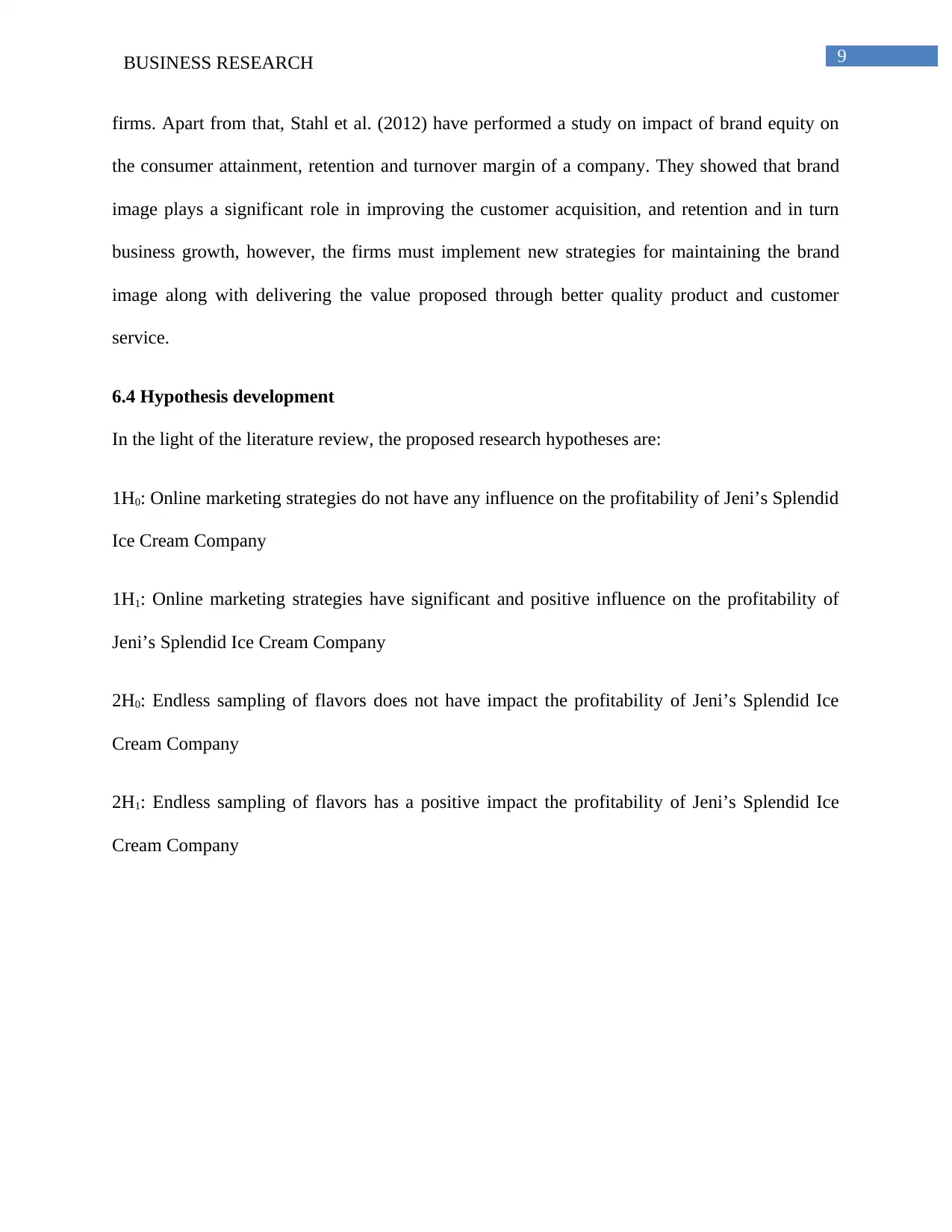
9BUSINESS RESEARCH
firms. Apart from that, Stahl et al. (2012) have performed a study on impact of brand equity on
the consumer attainment, retention and turnover margin of a company. They showed that brand
image plays a significant role in improving the customer acquisition, and retention and in turn
business growth, however, the firms must implement new strategies for maintaining the brand
image along with delivering the value proposed through better quality product and customer
service.
6.4 Hypothesis development
In the light of the literature review, the proposed research hypotheses are:
1H0: Online marketing strategies do not have any influence on the profitability of Jeni’s Splendid
Ice Cream Company
1H1: Online marketing strategies have significant and positive influence on the profitability of
Jeni’s Splendid Ice Cream Company
2H0: Endless sampling of flavors does not have impact the profitability of Jeni’s Splendid Ice
Cream Company
2H1: Endless sampling of flavors has a positive impact the profitability of Jeni’s Splendid Ice
Cream Company
firms. Apart from that, Stahl et al. (2012) have performed a study on impact of brand equity on
the consumer attainment, retention and turnover margin of a company. They showed that brand
image plays a significant role in improving the customer acquisition, and retention and in turn
business growth, however, the firms must implement new strategies for maintaining the brand
image along with delivering the value proposed through better quality product and customer
service.
6.4 Hypothesis development
In the light of the literature review, the proposed research hypotheses are:
1H0: Online marketing strategies do not have any influence on the profitability of Jeni’s Splendid
Ice Cream Company
1H1: Online marketing strategies have significant and positive influence on the profitability of
Jeni’s Splendid Ice Cream Company
2H0: Endless sampling of flavors does not have impact the profitability of Jeni’s Splendid Ice
Cream Company
2H1: Endless sampling of flavors has a positive impact the profitability of Jeni’s Splendid Ice
Cream Company
Paraphrase This Document
Need a fresh take? Get an instant paraphrase of this document with our AI Paraphraser
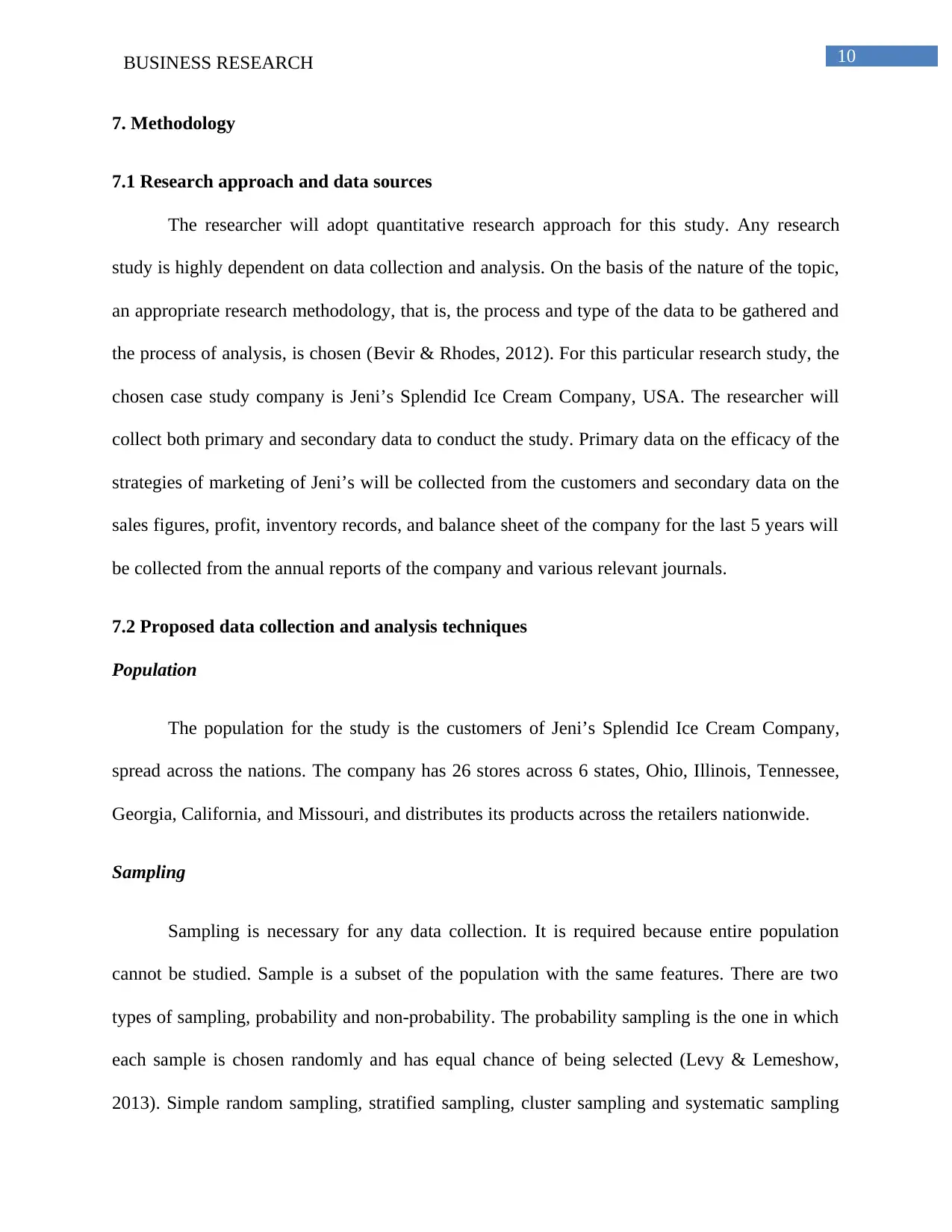
10BUSINESS RESEARCH
7. Methodology
7.1 Research approach and data sources
The researcher will adopt quantitative research approach for this study. Any research
study is highly dependent on data collection and analysis. On the basis of the nature of the topic,
an appropriate research methodology, that is, the process and type of the data to be gathered and
the process of analysis, is chosen (Bevir & Rhodes, 2012). For this particular research study, the
chosen case study company is Jeni’s Splendid Ice Cream Company, USA. The researcher will
collect both primary and secondary data to conduct the study. Primary data on the efficacy of the
strategies of marketing of Jeni’s will be collected from the customers and secondary data on the
sales figures, profit, inventory records, and balance sheet of the company for the last 5 years will
be collected from the annual reports of the company and various relevant journals.
7.2 Proposed data collection and analysis techniques
Population
The population for the study is the customers of Jeni’s Splendid Ice Cream Company,
spread across the nations. The company has 26 stores across 6 states, Ohio, Illinois, Tennessee,
Georgia, California, and Missouri, and distributes its products across the retailers nationwide.
Sampling
Sampling is necessary for any data collection. It is required because entire population
cannot be studied. Sample is a subset of the population with the same features. There are two
types of sampling, probability and non-probability. The probability sampling is the one in which
each sample is chosen randomly and has equal chance of being selected (Levy & Lemeshow,
2013). Simple random sampling, stratified sampling, cluster sampling and systematic sampling
7. Methodology
7.1 Research approach and data sources
The researcher will adopt quantitative research approach for this study. Any research
study is highly dependent on data collection and analysis. On the basis of the nature of the topic,
an appropriate research methodology, that is, the process and type of the data to be gathered and
the process of analysis, is chosen (Bevir & Rhodes, 2012). For this particular research study, the
chosen case study company is Jeni’s Splendid Ice Cream Company, USA. The researcher will
collect both primary and secondary data to conduct the study. Primary data on the efficacy of the
strategies of marketing of Jeni’s will be collected from the customers and secondary data on the
sales figures, profit, inventory records, and balance sheet of the company for the last 5 years will
be collected from the annual reports of the company and various relevant journals.
7.2 Proposed data collection and analysis techniques
Population
The population for the study is the customers of Jeni’s Splendid Ice Cream Company,
spread across the nations. The company has 26 stores across 6 states, Ohio, Illinois, Tennessee,
Georgia, California, and Missouri, and distributes its products across the retailers nationwide.
Sampling
Sampling is necessary for any data collection. It is required because entire population
cannot be studied. Sample is a subset of the population with the same features. There are two
types of sampling, probability and non-probability. The probability sampling is the one in which
each sample is chosen randomly and has equal chance of being selected (Levy & Lemeshow,
2013). Simple random sampling, stratified sampling, cluster sampling and systematic sampling

11BUSINESS RESEARCH
are types of probability sampling. On the other hand, under non-probability sampling, each
sample has no equal chance of being chosen and it is mostly based on the subjective judgment of
the researcher (Uprichard, 2013). For the given research, the researcher will pick a sample with
60 customers through simple random sampling. The survey questionnaire form will be handed
out to the random customers at the stores in Ohio for primary data collection regarding the
effectiveness of the marketing strategies adopted by Jeni’s.
Variables and analysis
The research study will evaluate the connection between the profitability of the company
and the marketing strategies adopted by it. A positive relationship is desired from the analysis. In
this case, effectiveness of marketing strategy is the independent variable and profitability of
Jeni’s is the dependent variable.
The researcher will be applying quantitative analysis on the gathered primary and
secondary data. The survey responses will be collected through a five point rating scale, such as,
the Likert scale and the responses will be converted into numeric values for applying the
statistical methods on it. Various statistical tools, such as, reliability test, correlation and
regression will be performed on the data to find out the strength and direction of the relationship
between the variables and the internal consistency. The patterns in the responses will be
illustrated through tables and bar graphs.
Secondary data on the sales figures and profits of the company in the last five years will
be analyzed using thematic analysis. This will be performed for providing validation to the
findings from the primary data. After both types of data analysis, the findings will be presented
under different themes, which are chosen according to the research objectives and interpretations
are types of probability sampling. On the other hand, under non-probability sampling, each
sample has no equal chance of being chosen and it is mostly based on the subjective judgment of
the researcher (Uprichard, 2013). For the given research, the researcher will pick a sample with
60 customers through simple random sampling. The survey questionnaire form will be handed
out to the random customers at the stores in Ohio for primary data collection regarding the
effectiveness of the marketing strategies adopted by Jeni’s.
Variables and analysis
The research study will evaluate the connection between the profitability of the company
and the marketing strategies adopted by it. A positive relationship is desired from the analysis. In
this case, effectiveness of marketing strategy is the independent variable and profitability of
Jeni’s is the dependent variable.
The researcher will be applying quantitative analysis on the gathered primary and
secondary data. The survey responses will be collected through a five point rating scale, such as,
the Likert scale and the responses will be converted into numeric values for applying the
statistical methods on it. Various statistical tools, such as, reliability test, correlation and
regression will be performed on the data to find out the strength and direction of the relationship
between the variables and the internal consistency. The patterns in the responses will be
illustrated through tables and bar graphs.
Secondary data on the sales figures and profits of the company in the last five years will
be analyzed using thematic analysis. This will be performed for providing validation to the
findings from the primary data. After both types of data analysis, the findings will be presented
under different themes, which are chosen according to the research objectives and interpretations
⊘ This is a preview!⊘
Do you want full access?
Subscribe today to unlock all pages.

Trusted by 1+ million students worldwide
1 out of 20
Related Documents
Your All-in-One AI-Powered Toolkit for Academic Success.
+13062052269
info@desklib.com
Available 24*7 on WhatsApp / Email
![[object Object]](/_next/static/media/star-bottom.7253800d.svg)
Unlock your academic potential
Copyright © 2020–2025 A2Z Services. All Rights Reserved. Developed and managed by ZUCOL.





